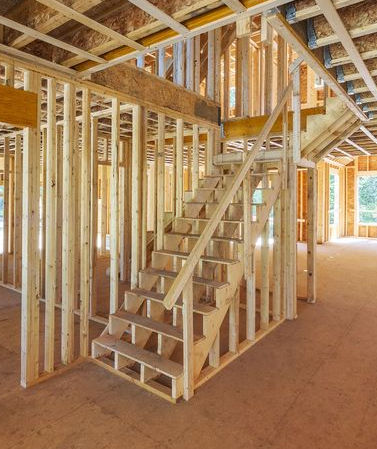24.E Stairways.
24.E.01 On all structures 20 ft (6 m) or more in height, stairways must be provided during construction.
- Where permanent stairways are not installed concurrently with the construction of each floor, a temporary stairway must be provided to the work level.
- Alternatives to the use of stairways must be addressed in the AHA and must be acceptable to the GDA.
24.E.02 Requirements for stairways.
- Temporary stairways must have landings not less than 30 in (76.2 cm) in the direction of travel and extend at least 22 in (55.8 cm) in width at every 12 ft (3.6 m) or less of vertical rise.
- Stairs must be installed between 30º and 50º from horizontal.
- Risers must be of uniform height and treads of uniform width.
24.E.03 Metal pan landings and metal pan treads, when used, must be secured in place and filled with concrete, wood, or other material at least to the top of each pan.
24.E.04 Wooden treads must be nailed in place.
24.E.05 Every flight of stairs with four or more risers or rising more than 30 in (76.2 cm) must have standard stair railings (defined below) or standard handrails, unless omitted by design.
- On stairways less than 44 in (111.7 cm) wide having both sides enclosed, at least one standard handrail must be installed, preferably on the right descending side.
- On stairways less than 44 in (111.7 cm) wide having one side open, at least one standard stair railing must be installed on the open side.
- On stairways less than 44 in (111.7 cm) wide having both sides open, one standard stair railing must be installed on each side.
- On stairways more than 44 in (111.7 cm) wide, but less than 88 in (223.5 cm) wide, one standard handrail must be installed on each enclosed side, and one standard stair railing installed on each open side.
- On stairways more than 88 in (223.5 cm) wide, one standard handrail must be installed on each enclosed side, one standard stair railing on each exposed side, and a standard handrail in the middle of the stairway.
24.E.06 Standard stair railing must be installed around all stairwells.
- The height of stair rails must be 42+/- 3 in ( 1 m +/- 8 cm) from the upper surface of the top rail to surface of tread in line with face of riser at forward edge of tread. Existing installations need not be modified. Existing installations need not be modified.
- Midrails, screens, mesh, intermediate vertical members, or equivalent intermediate structural members must be provided between the toprail and the stairway steps.
- (1) Midrails must be located at a height midway between the top edge of the stairway system and the stairway steps.
- (2) Screens or mesh, when used, must extend from the toprail to the stairway steps and along the entire opening between rail supports.
- (3) Intermediate vertical members, when used, must be not more than 19 in (48.2 cm) apart.
- (4) Other structural members, when used, must be installed in such a manner that there are no openings in the stair rail system that are more than 19 in (48.2 cm) wide.
24.E.07 Doors or gates opening onto a stairway must have a platform; and swinging of the door must not reduce the width of the platform to less than 20 in (50.8 cm).
24.E.08 Spiral stairways must not be permitted, except for special limited usage and secondary access where it is not practical to provide a conventional stairway.
24.E.09 Three points of contact must be maintained at all times when ascending or descending spiral stairs, ship stairs, or alternating tread stairs. Three point contact means that either both hands and one foot, or both feet and one hand are in contact with the climbing device at all times.
Knowledge Check Choose the best answer for the question.
24-7. Stair risers must be of uniform height, treads of uniform widths, and _____.
You forgot to answer the question!

